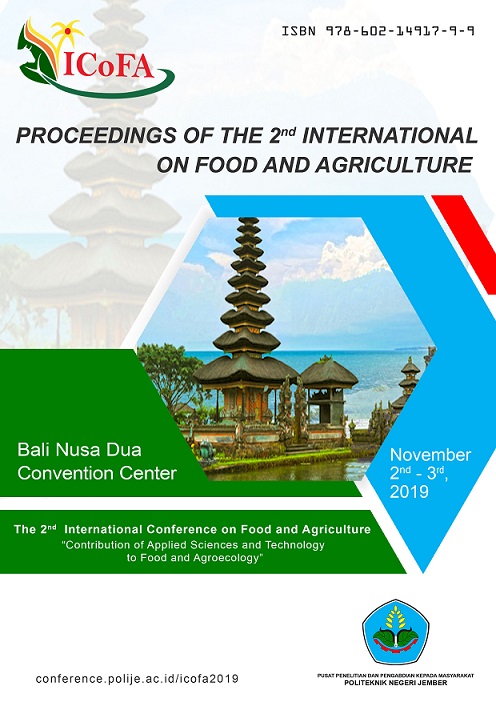TEMPEH SOYBEANS WITH LOCAL PRODUCTION FROM A NEW METHODS
Abstract
Politeknik Negeri Jember (POLIJE) is the leading vocational institutions that promote applied research as a form of downstream to solved the problems of stakeholders (both industry and society). The indicator of the vocational college’performance is the number of innovations that have been implemented in the industry and society. One of the problems found in the SME community partners primarily in the food industry, especially in the tempeh processing industry. Making tempeh with local raw materials and traditional methods requires a lot of water and the product also decays quickly. POLIJE team, Wibisono; Santoso and Budiati initiated industrial tempeh in Al Islah Jenggawah Jember for using local soybean. Training and coaching activities is funded by the Indonesian Ministry of Research, Technology and Higher Education through PKM Programs (Community Partnership Program). In the event, POLIJE team giving equipment to the process of making modern tempeh, such as an incubator for the production of special ragi (yeast) equipped with gear sensor (sensor cable thermometer, TDS tester and others); soybean washing machine; soybeans peeler (for the development of turnover) as well as digital microwave for preparation of media for yeast. In the treatment process before the community service is to get local tempe with the highest levels of genistein. As for the treatment factor is the type of yeast which includes raprima (factory made) yeast with artificial yeast based on the Wibisono method. The duration of fermentation uses a time duration of 0; 6; 12; 18 and 24 hours. Each time fermentation has been determined, genistein (and genistin) is tested. The research results above indicate that optimal hydrolysis of genistin is carried out at 43 o ISBN : 978-602-14917-9-9 C for 18 hours. PP Al Islah recognize that using washers soybeans, can save up to 30 minutes each 100 kg of material and no raw material is wasted, and it can save water usage so that will be able to reduce water tempeh industrial waste products. The results showed no difference in the value of TSS (Total Suspended Solid) between manual washing compared with modern equipment, Also results of research studies the content of genistein showed increased by 33% compared to conventional methods.References
Acebron, I; Curiel, J; Rivas, B; Munoz, R; and Mancheno, J. 2009. Cloning, Production, Purification and Preliminary Crystallographic Analysis of a Glycosidase from the Food Lactic Acid Bacterium Lactobacillus plantarum CECT 748. J. Protein Expression and Purification. 68(2009): 177182
Audisio, M.C; Torres, M.J; Sabate, D.C, Ibarguren, C; and Apella, M.C. 2011. Properties of Different Lactic Acid Bacteria Isolated from Apis mellifera L. bee-gut. 166(2011): 1-13
Nielsen, D; Cho, G; Hanak, A; Huch, M; Franz, C.M.A.P; and Arneborg, N. 2010. International Journal of Food Microbiology. 141(2010): 553-559
Parente, E; Ciocia, F; Ricciardi, A; Zotta, T, Felis, G.E; and Torriani, S. 2010. Diversity of Stress Tolerance in Lactobacillus paraplantarum: A Multivariate Screening Study. J. International Journal of Food Microbiology. 144(2010): 270-279
Setiawan, A. 2018. Soybean Jember. http://setkab.go.id/ kedelai-jember-tembus-pasarinternasional/ Accessed on August 2,2018
Wibisono, Y. 2010. Production Process Tempe with L. plantarum Formulations and Rice Flour to Extend Shelf Life and Improving the Nutrition a lValue of Soy Edamame Tempe sort order. Minutes of a Simple Patent.

